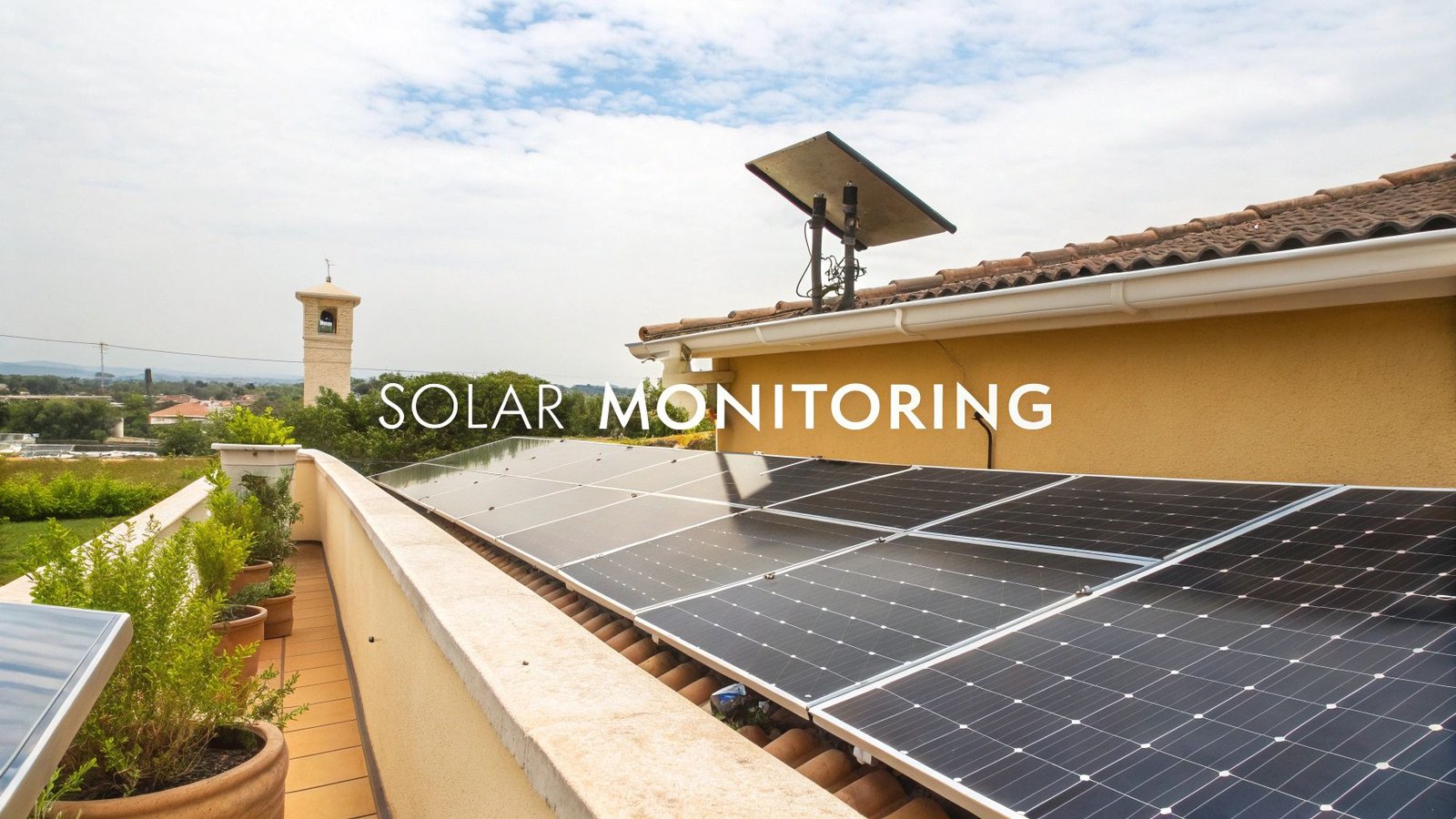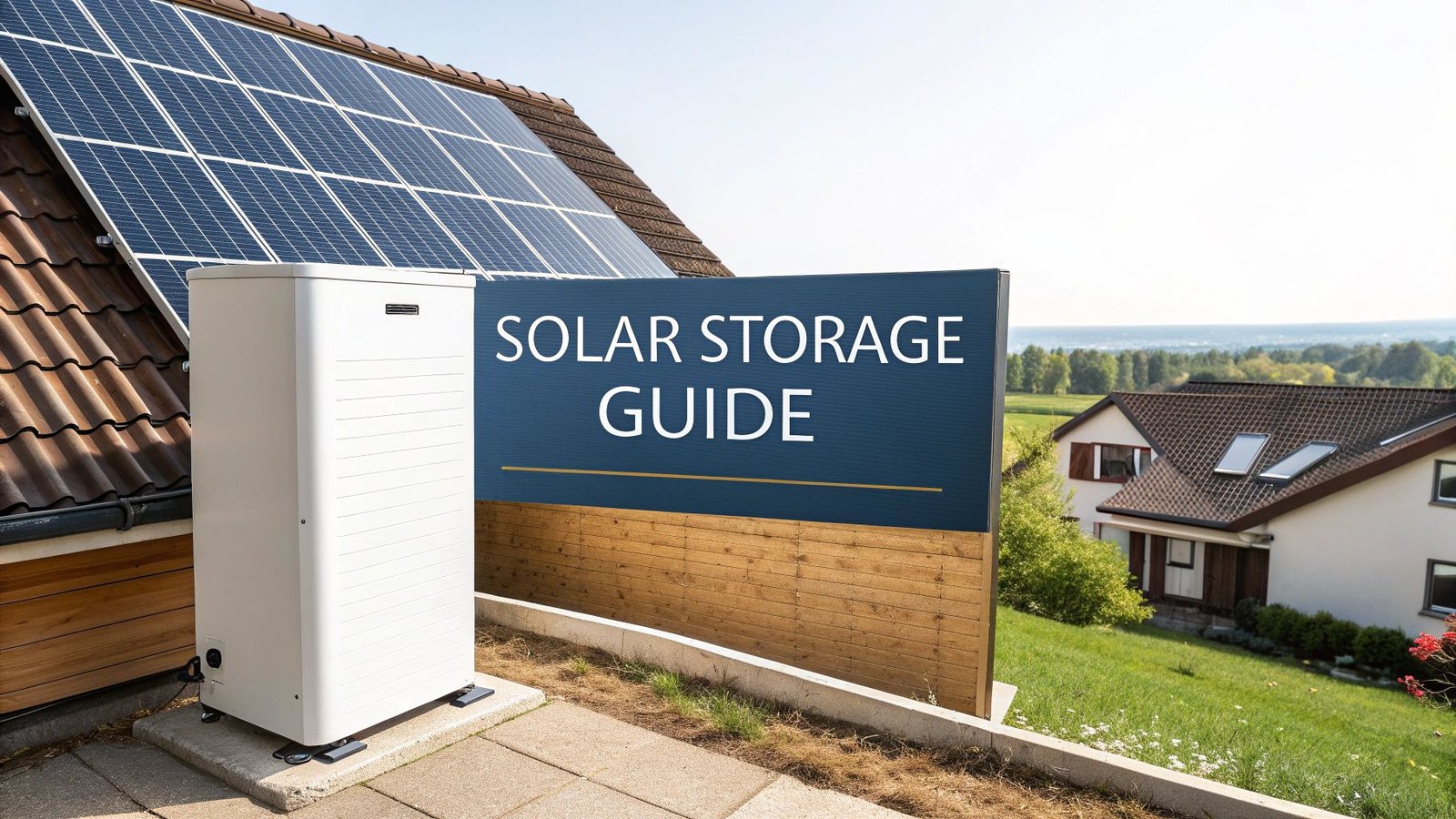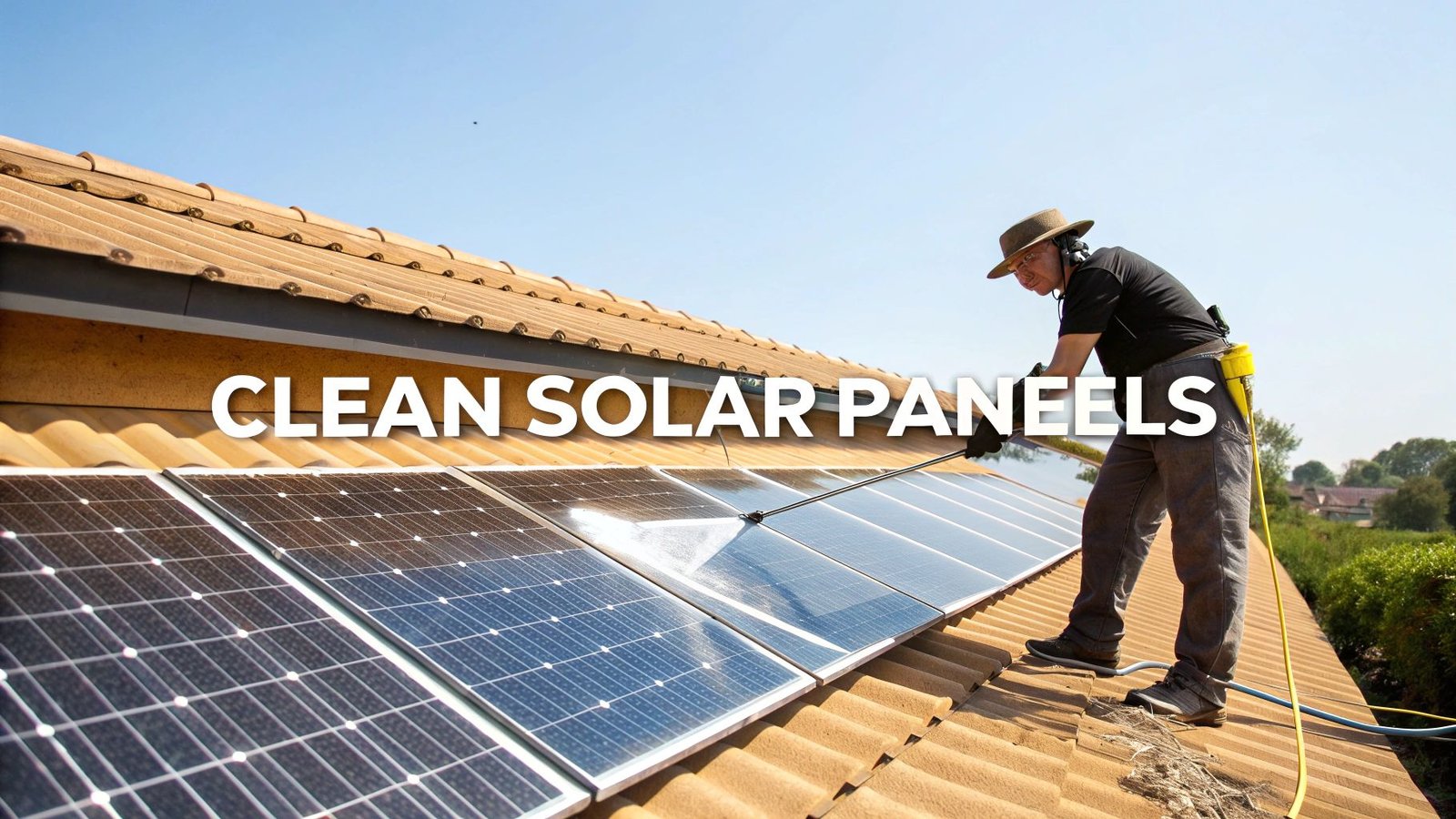Imagine getting a smart watch for your solar panels. That's essentially what a solar monitoring system is—a dedicated tool giving you a real-time feed on your system's performance, health, and efficiency. It doesn't just tell you if the system is on or off; it tracks every watt of energy you produce, monitors what your home is using, and immediately flags any hiccups. This isn't just a gadget; it's a vital part of maximizing your solar investment.
Unlocking Your Solar Panel's Full Potential
Think of your solar panels like the engine in your car. Without a dashboard, you'd have no idea how fast you're going, if you're low on fuel, or if the engine is overheating. A solar monitoring system is that crucial dashboard for your energy system. It takes all the complex electrical data and translates it into simple, easy-to-understand insights, making sure you get every last kilowatt-hour of clean energy you paid for.
This constant stream of information answers the most important questions you have about your system:
- How much power are my panels making right now? What about all day yesterday, or over the last month?
- Is my house using more electricity than my panels are producing?
- Is one specific panel lagging behind because it's dirty, shaded, or has a technical issue?
Understanding the Core Functions
At its heart, a solar monitoring system gives you complete visibility into your personal energy world. It tracks the flow of electricity from the panels on your roof, into your home's appliances, and even back to the grid when you have extra to share. This gives you a crystal-clear picture of your energy independence. With this data, you can start to see patterns, spot where energy is being wasted, and make smarter decisions about how and when you use power.
A solar panel array without a monitoring system is a silent partner. You might not notice a 15-20% drop in production for months, and that quiet problem could be costing you hundreds in lost savings. Monitoring turns that silent asset into a transparent, high-performing investment you can actually manage.
The Growing Importance of Solar Monitoring
As the world continues to pour money into renewable energy, the need for reliable ways to track performance has exploded. Solar projects now account for roughly 59% of all renewable energy investments globally, which adds up to about $393 billion. You can dig into these investment trends over at Fortune Business Insights. With this much at stake, monitoring systems that ensure these assets are working efficiently are no longer a luxury—they're a necessity.
This technology shifts the power dynamic for homeowners. You go from being just a passive consumer of electricity to an active manager of your own energy production. When you know exactly how your system is performing, you can catch small issues early, prevent them from turning into expensive repairs, and ultimately make sure your solar installation delivers on its financial and environmental promises for years to come.
How Solar Monitoring Systems Work
A solar monitoring system pulls back the curtain on your solar panels, giving you a direct line to crucial performance data right on your phone or computer. It’s a bit like having a sophisticated dashboard for your home’s power plant.
Think of it this way: a weather station tracks things like temperature and rainfall, right? Your monitoring system does the same for your solar array, but instead of tracking weather, it’s tracking energy—how much you’re making, how much you’re using, and where it’s all going.
This whole process is surprisingly straightforward and breaks down into a simple three-step journey, starting with the hardware on your roof and ending with an easy-to-read app.
Step 1: Data Collection at the Source
First things first, you need to actually gather the information. This job falls to the specialized hardware that’s part of your solar installation.
- Sensors and Meters: These are the workhorses. They're connected directly to your panels and inverter, constantly measuring key electrical stats like voltage, current, and total power output in real-time.
- The Inverter's Role: Your inverter is the brain of the solar operation, converting DC power from the panels into the AC power your home uses. It's also the central hub for collecting all this data. Most modern inverters have this monitoring capability built right in.
This equipment captures a continuous stream of electrical data, giving you a second-by-second account of your system's energy production. To get a better feel for how these pieces fit together in the bigger picture, check out our guide on how home solar works.
The image here shows how the key components—the panels, inverter, and monitoring device—collaborate to capture your energy data.
This setup is the physical foundation of any good solar monitoring system, turning raw sunlight into data points you can actually use.
Step 2: Sending Information to the Cloud
Once all that raw data is collected, it can't just sit on your roof. It needs to be sent somewhere for processing and storage. This is where a small but mighty device, often called a gateway o data logger, steps in.
The gateway is essentially a communication bridge. It bundles up all the information from the inverter and sensors and sends it on its way.
Using your home's Wi-Fi or a dedicated cellular link, the gateway securely beams this data to a cloud server. Storing your performance history in the cloud is what allows you to track trends over months or years and, just as importantly, lets you check in on your system from anywhere in the world.
Step 3: Translating Data into Insights
The final—and most useful—step is turning all that complicated electrical data into something you can quickly understand. This is the job of the software, which usually comes in the form of a polished mobile app or a web dashboard.
This is where the magic happens. The software crunches all the raw numbers and presents them as simple, intuitive charts and graphs. You can see your energy production ebb and flow throughout the day, compare this month's output to last year's, or get an instant alert if a panel isn't performing as it should.
This visual interface is what makes a solar monitoring system so powerful. It’s no longer just a technical tool for an installer; it’s an essential part of managing your home's energy, giving you the power to spot issues early, adjust your usage, and make sure you’re getting every penny’s worth from your investment.
Key Benefits for Homeowners
Think of a solar monitoring system as more than just a fancy gadget that tells you if your panels are "on." It's your command center, giving you the power to actively manage your energy investment. This kind of visibility delivers real savings and genuine peace of mind, all based on data sent right to your phone or computer. The advantages aren't just about satisfying curiosity; they have a direct, positive impact on your wallet and the health of your system for years to come.
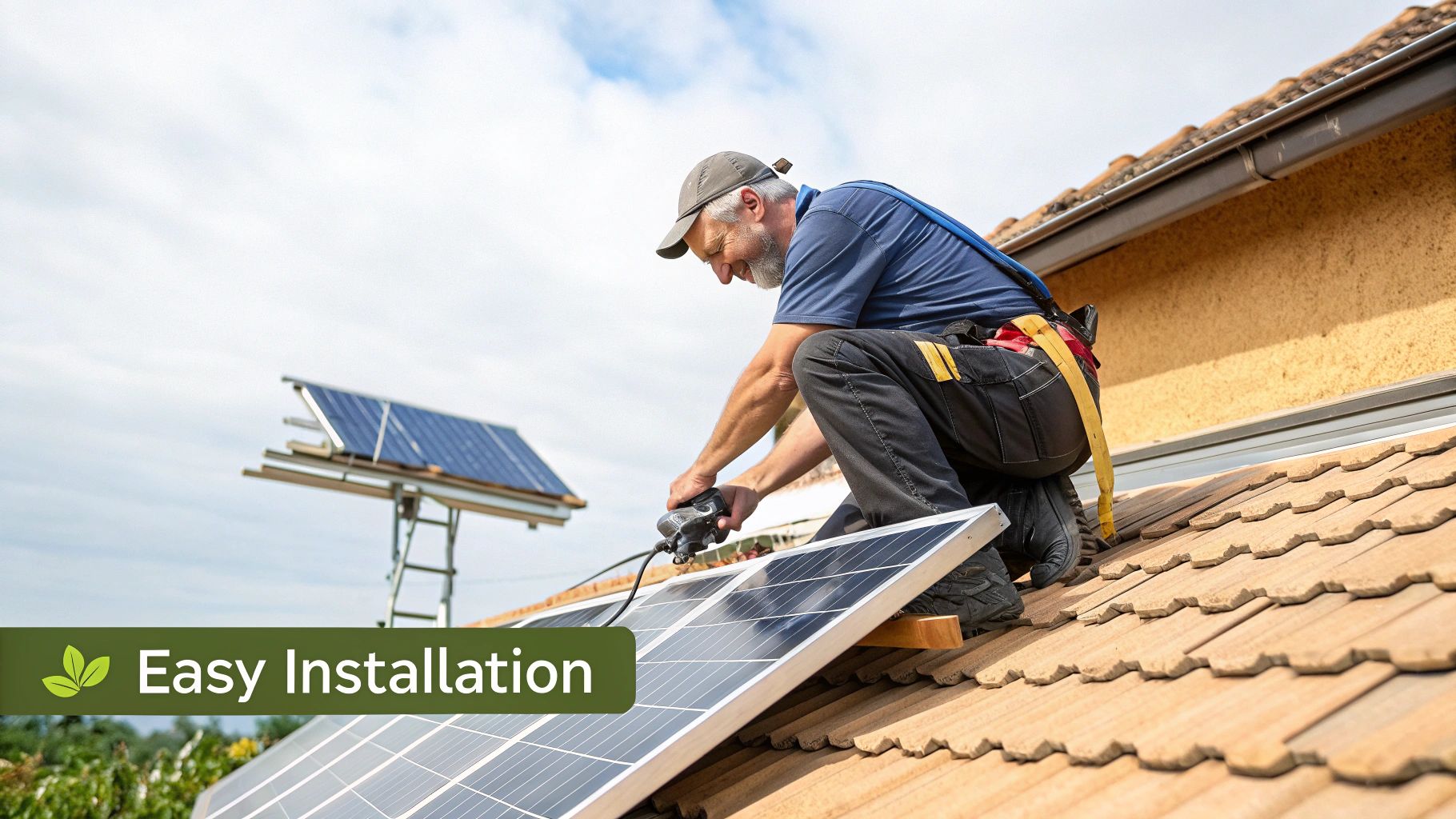
This technology is a huge part of why solar is taking off globally. The market for solar PV monitoring systems was already valued at around $5 billion in 2025 and is expected to explode to nearly $15 billion by 2033. Why the massive growth? It's driven by homeowners just like you who want smarter control over their own power.
Maximize Your Energy Production
Without a monitoring system, your solar array is basically a black box. A gradual drop in performance could go unnoticed for months, costing you a small fortune in lost savings. A good monitoring system is like having a detective on the case 24/7, instantly spotting the little issues that quietly drain your energy output.
Imagine seeing a sudden 15% dip in your daily production on the app. That's your first clue. It prompts you to take a look and discover the culprit—maybe a bird's nest is shading a corner of your array, or a thick layer of dust has settled after a dry spell. Finding it early prevents you from losing a whole season's worth of clean energy.
Optimize Your Energy Usage
Knowing cuando your system is cranking out the most power is a total game-changer for your household budget. Your monitoring app will show you a simple graph of your peak production hours, which is almost always in the middle of the day. The chart below illustrates a typical daily cycle, showing how solar production (blue line) peaks midday while home consumption (orange line) has its own patterns.
{
"type": "line",
"data": {
"labels": ["6 AM", "8 AM", "10 AM", "12 PM", "2 PM", "4 PM", "6 PM", "8 PM"],
"datasets": [
{
"label": "Solar Production (kWh)",
"data": [0.1, 1.5, 3.8, 5.0, 4.5, 2.5, 0.5, 0],
"borderColor": "rgba(54, 162, 235, 1)",
"backgroundColor": "rgba(54, 162, 235, 0.2)",
"fill": true
},
{
"label": "Home Consumption (kWh)",
"data": [0.5, 1.2, 0.8, 1.0, 1.1, 2.0, 3.5, 2.0],
"borderColor": "rgba(255, 159, 64, 1)",
"backgroundColor": "rgba(255, 159, 64, 0.2)",
"fill": true
}
]
},
"options": {
"responsive": true,
"plugins": { "title": { "display": true, "text": "Typical Daily Solar Production vs. Home Consumption" } },
"scales": { "y": { "beginAtZero": true } }
}
}
By aligning your energy-heavy tasks—like running the dishwasher, washing machine, or pool pump—with these peak hours, you effectively use free electricity straight from the sun. This simple shift in habit reduces your reliance on the grid and lowers your utility bills even further.
This data-first approach to how you use energy means you’re getting the most out of every sunbeam, maximizing your return on investment every single day.
Ensure Long-Term System Health
Catching problems early is easily one of the most valuable benefits of a solar monitoring system. It helps stop minor glitches from turning into major, expensive repairs down the road. The system keeps a constant eye on your inverter and panels, flagging anything that looks out of place right away.
This proactive approach to maintenance is vital whether you own your system outright or are exploring other financing options. In fact, knowing your system is performing as it should is critical no matter how you paid for it. To get a better handle on those choices, check out our guide on the differences between solar leasing vs. Power Purchase Agreements (PPAs).
Ultimately, continuous monitoring gives you the confidence that your solar investment is safe, secure, and working at its best for its entire lifespan.
How to Choose the Right System
Picking the right solar monitoring system is a big deal—it shapes how you’ll interact with your solar investment for years to come. This isn't a one-size-fits-all situation. The best system for you really hinges on your budget, your goals, and just how deep into the data you want to dive.
Think of it like this: are you happy with a basic car dashboard that just shows your speed and fuel level, or do you want the high-tech display that gives you real-time engine diagnostics and tire pressure for each wheel? The first question to ask yourself is about monitoring granularity—do you want a bird's-eye view of your whole system, or do you need to see what every single panel is doing?
System-Level vs. Panel-Level Monitoring
A system-level (or string-level) monitoring setup is the straightforward, no-fuss option. It gives you the big picture: the total amount of electricity your entire solar array is generating. This is a solid, cost-effective choice for homeowners who mainly want to confirm their system is up and running and hitting its expected production numbers.
Por otro lado, panel-level monitoring is for those who want a much closer look. Using microinverters or power optimizers, this approach tracks the performance of each individual panel. You can instantly see if a specific panel is lagging due to a bit of shade, some stubborn dirt, or a technical glitch. It costs more upfront, but this detailed insight is a game-changer for troubleshooting and squeezing every last watt out of your system for the long haul.
For more on the hardware that makes this possible, our guide on how to choose the right solar panels dives into the details.
Comparison of Solar Monitoring System Features
To really get a feel for what’s right for you, it helps to see these two approaches laid out side-by-side. The decision usually comes down to balancing how much you want to spend with how much information you want at your fingertips.
This table breaks down the key differences to help you decide.
| Característica | Basic System (String-Level) | Advanced System (Panel-Level) | Key Consideration for Homeowners |
|---|---|---|---|
| Data Granularity | Gives you a collective overview of total system production. You see one number for the whole array. | Shows real-time production data for every single panel, allowing for precise performance analysis. | Do you want a simple summary or the ability to micromanage and optimize? |
| Fault Detection | Can show a big drop in overall output, but won't tell you where the problem is. | Instantly flags an underperforming or failed panel, making troubleshooting much faster and more accurate. | How quickly and easily do you want to be able to identify and fix issues? |
| User Interface (UI) | Usually a simpler dashboard with basic charts showing daily, monthly, and yearly energy production. | Often has a more dynamic, detailed interface with a visual layout of your roof showing each panel's live status. | How important is a detailed, user-friendly, and visually engaging app experience to you? |
| Smart Home Integration | Might have limited options for connecting with other devices like smart thermostats, batteries, or EV chargers. | Typically designed for seamless integration with a whole smart home ecosystem for total energy management. | Are you planning to build a fully integrated smart home where your solar, battery, and EV charger all work together? |
| Overall Cost | Lower upfront cost since the hardware is less complex. | Higher initial investment because it requires a microinverter or power optimizer for each panel. | What is your budget, and how much value do you place on having advanced data and control? |
Ultimately, the best choice depends on how hands-on you want to be with your home’s energy. If you’re a "set it and forget it" type, system-level monitoring is often plenty. But if you're someone who wants to maximize every bit of power and get ahead of problems, panel-level monitoring is definitely the way to go.
The Future of Solar Monitoring
Today's monitoring dashboards are impressive, but they're really just the beginning. The solar monitoring system of tomorrow is shaping up to be much more than a simple reporting tool—it’s becoming the intelligent energy brain for your entire home. We're moving away from systems that just tell you what happened yesterday and into a new era where they predict what's coming next, turning your solar setup into a truly proactive asset.
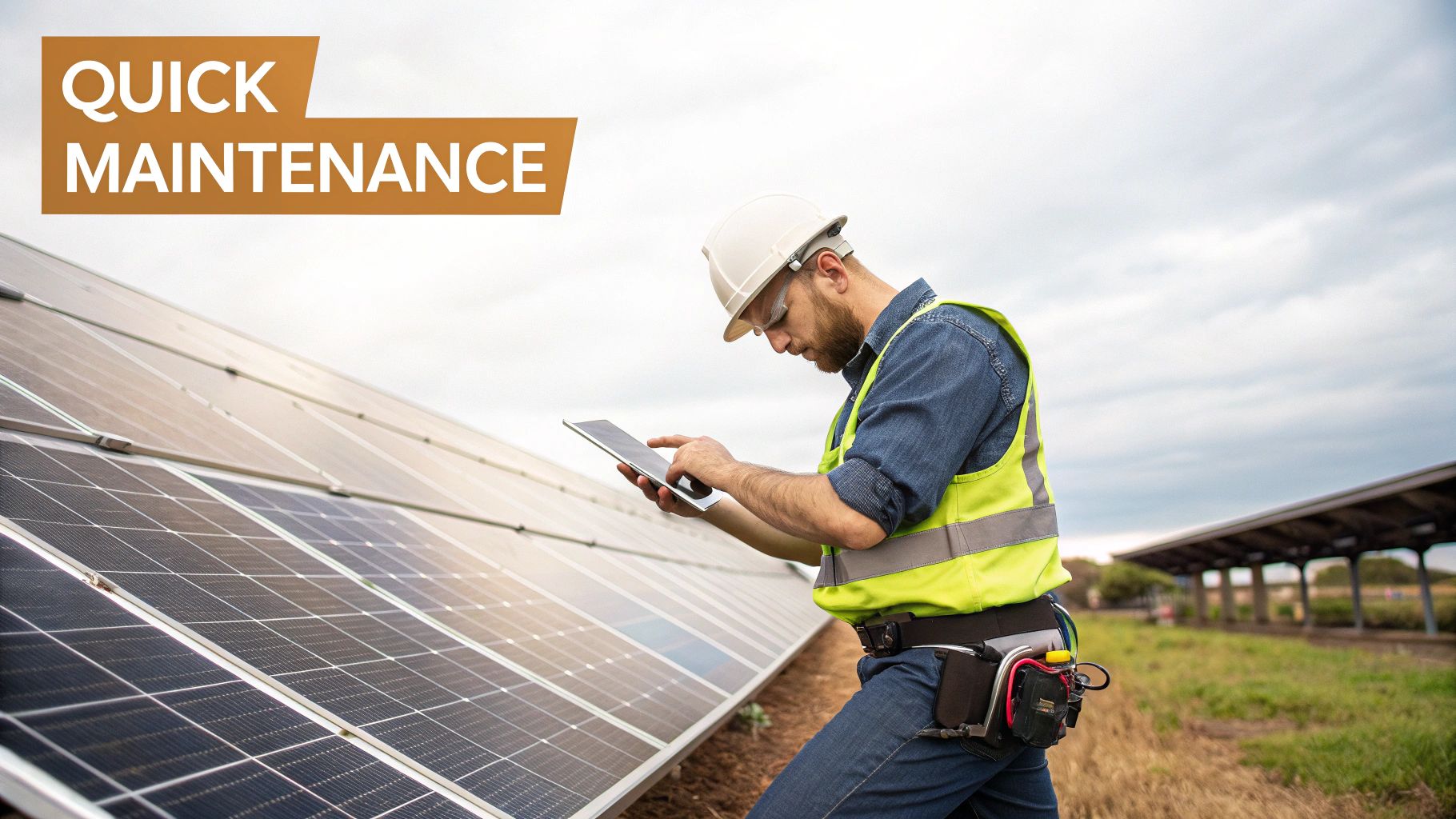
This evolution is being driven by two key technologies: Artificial Intelligence (AI) and the Internet of Things (IoT). They’re making these systems smarter and more connected than ever before. It's a massive shift, and the global market is exploding—projected to be worth $15 billion by 2025. This growth is almost entirely thanks to these new technologies that make solar more efficient and valuable for homeowners.
AI-Powered Predictive Analytics
Think of your future monitoring system as a personal energy forecaster. That's the power of AI-powered predictive analytics. By constantly crunching data on local weather forecasts and your own system's past performance, it can give you a surprisingly accurate picture of how much energy you'll generate tomorrow or even next week.
But it gets even better. This predictive power also applies to the health of your system. AI algorithms can spot tiny dips or inconsistencies in performance data that are invisible to the human eye. These small signals often precede a hardware problem, allowing the system to alert you to a potential issue before it actually fails. This foresight is a game-changer, helping you minimize downtime and fix small issues before they snowball into expensive repairs.
Instead of just reacting to problems, your system will help you get ahead of them. It's the difference between seeing an error code después de your inverter dies versus getting a notification that says, "Performance suggests your inverter may need a check-up in the next 30 days."
The Central Brain of Your Smart Home
Perhaps the most exciting development is how IoT integration is turning the solar monitoring system into the command center for your home's entire energy ecosystem. It’s no longer just a separate app for your solar panels; it's the core coordinator for all of your major energy-consuming devices.
Imagine your system automatically managing the flow of electricity to:
- Your EV Charger: It will know to start charging your electric vehicle in the middle of the day when your solar production is highest, giving you a "fill-up" with free, clean energy.
- Battery Storage: It will intelligently decide the best time to store excess solar power in your battery or when to draw from that battery to power your home, keeping you from buying expensive electricity from the grid during peak hours.
- Smart Thermostat: It can pre-cool your home during the sunniest part of the afternoon, using abundant solar power to reduce the need to run the AC on grid power later in the evening.
This kind of smart coordination makes sure that every single kilowatt-hour your panels produce is put to the best possible use. It's what makes a modern monitoring system a future-proof investment in genuine energy independence.
Answering Your Solar Monitoring Questions
Thinking about adding a monitoring system to your solar setup? It’s smart to have a few questions. Getting straight answers is the best way to feel confident about your decision, so let's tackle some of the most common ones we hear from homeowners.
What's the Real Cost of a Solar Monitoring System?
This is a great question, and the honest answer is: it depends.
For most people buying a new solar array today, the good news is that monitoring is often built right into the modern inverters from top brands. In that case, the cost is simply part of your total solar installation package. No extra line item to worry about.
However, if you're looking to add monitoring to an older system, you'll likely need a standalone device. These can range from a few hundred dollars for a basic unit to over $1,000 for a more sophisticated one.
So, what's behind that price gap? It really boils down to the level of detail you want. Systems that give you a deep dive into panel-level performance and offer predictive maintenance alerts will naturally sit at the higher end. Keep in mind, some services also have a small monthly or annual subscription for storing your data in the cloud and giving you access to their premium app features.
The chart below gives you a quick visual on how features can influence the price.
Will a Monitoring System Work With My Existing Solar Panels?
Compatibility is a huge consideration, especially if your solar panels have been on your roof for a few years. If you have a modern inverter, there's a good chance it already has monitoring capabilities waiting to be activated.
For older systems, you'll probably need a third-party monitoring device. These are specifically designed to be retrofitted, connecting to your current hardware to read and transmit performance data. They act as a bridge between your existing tech and today's monitoring platforms.
The absolute best way to know for sure is to chat with a pro. Your original installer or another qualified solar technician can take a look at your specific panels and inverter and point you toward the right solution.
How Do I Know My Energy Data Is Secure?
In a world full of data breaches, this is a perfectly valid concern. Your energy usage patterns are private information, and reputable monitoring companies treat them that way.
They use multiple layers of protection. Your data is typically encrypted both when it travels from your system to the cloud and while it's stored on their servers. Think of it like a digital armored car. On top of that, your account is protected by a password, and many platforms now require two-factor authentication (2FA) to log in, adding another crucial lock.
Before you commit to any system, it's always a good idea to read through the provider's privacy policy. It will tell you exactly how they protect your information from anyone who shouldn't see it.
Ready to see exactly what your solar panels are doing for you? The team at Energía radiante can design a complete solar solution with powerful, easy-to-use monitoring from day one. Explore our solar solutions and get a free quote today!

